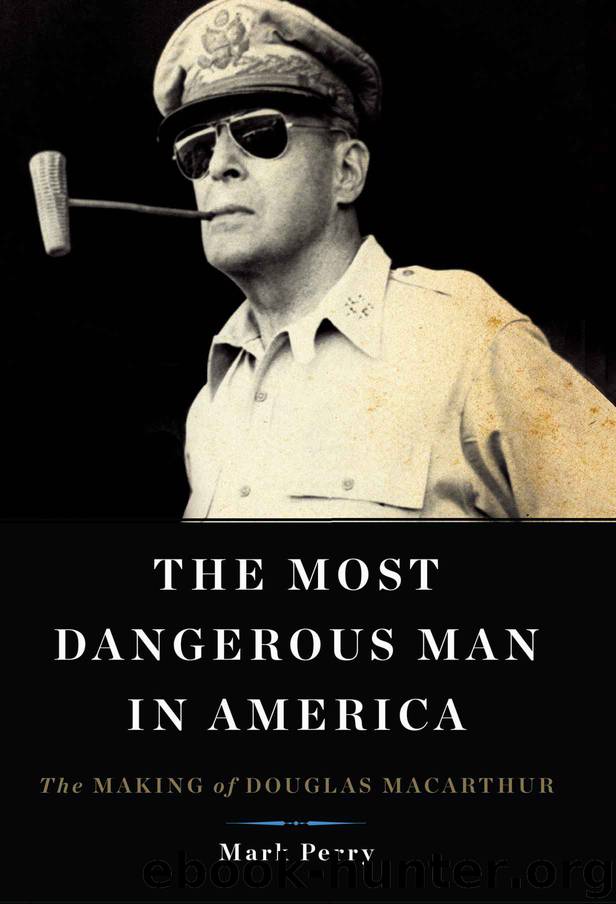The Most Dangerous Man in America: The Making of Douglas MacArthur by Perry Mark

Author:Perry, Mark [Perry, Mark]
Language: eng
Format: epub
ISBN: 9780465013289
Publisher: Basic Books
Published: 2014-04-01T00:00:00+00:00
Although 1942 was a bad year for Roosevelt, it was even worse for MacArthur. Morose over his escape from Corregidor, stunned by the lack of resources that greeted him in Australia, and frustrated by his long-distance exchanges with Marshall and Roosevelt, MacArthur remained a Melbourne recluse. After his exchange with Roosevelt, MacArthur cabled Hap Arnold that the Japanese could take New Guinea “at will.” Pessimism seeped from his cables. MacArthur’s spirits were buoyed by news of General Jimmy Doolittle’s surprise aerial attack on Tokyo in April. Carried out by thirteen B-25s launched from the USS Hornet (it had been his idea, MacArthur harrumphed to his aides), the strike lifted morale and provided evidence that Japan was vulnerable. But whatever lift MacArthur received from the Doolittle raid was short-lived. At the end of April, even before Wainwright’s surrender on Corregidor, Army Air Force Brigadier General Harold George (who had headed up Lewis Brereton’s “pursuit command” in the Philippines and preceded him to Australia) died in a freak accident at Batchelor Field, near Darwin, when a P-40 veered off course and killed him. MacArthur’s period of mourning was unusually long; he had admired George and the two were close friends. MacArthur needed good news, and desperately. It came, finally, during the first week of May.
On May 4, the Japanese Imperial Navy entered the Coral Sea looking for U.S. aircraft carriers. The Japanese task force, led by ascetic Vice Admiral Shigeyoshi Inoue (with two aircraft carriers—Shokaku and Zuikaku), shielded an invasion force of eleven troop transports carrying four thousand soldiers of the South Seas Detachment bound for Port Moresby. In Hawaii, Chester Nimitz was warned of the Japanese offensive by cable intercepts and dispatched Admiral Frank “Jack” Fletcher and two aircraft carriers, Yorktown and Lexington, to intercept them. Alerted to the Japanese move by Nimitz, MacArthur directed his skeletal Allied Air Force to scout north of New Guinea for Japanese naval movements, then sent three cruisers to reinforce Fletcher. Beginning on May 7, Fletcher and Inoue exchanged the first blows of the two-day battle, the first in history where two navies fought each other solely with aircraft. The first day’s encounter was indecisive, though American planes found and sank the light carrier Shoho and the Japanese sank two American tankers. But on the second day, Fletcher was able to find and damage Shokaku. He paid a heavy price: Lexington, hit by two torpedoes and three bombs, was set afire and sunk. Fletcher, with Yorktown also damaged, broke off contact and limped south. The Battle of the Coral Sea is considered a draw by most naval historians, but it was viewed as a setback by the Japanese. Japan’s planned conquest of Port Moresby was postponed, and the South Seas Detachment was ordered back to Rabaul.
There was better news to come. Stymied by Fletcher in the Southwest Pacific, Isoroku Yamamoto, Japan’s premier naval commander, decided to finish the job begun by Admiral Chuichi Nagumo at Pearl Harbor by luring U.S. aircraft carriers into a much-anticipated “decisive battle.
Download
This site does not store any files on its server. We only index and link to content provided by other sites. Please contact the content providers to delete copyright contents if any and email us, we'll remove relevant links or contents immediately.
| Africa | Americas |
| Arctic & Antarctica | Asia |
| Australia & Oceania | Europe |
| Middle East | Russia |
| United States | World |
| Ancient Civilizations | Military |
| Historical Study & Educational Resources |
The Radium Girls by Kate Moore(10914)
The Templars by Dan Jones(4192)
100 Deadly Skills by Clint Emerson(4085)
Rise and Kill First by Ronen Bergman(4018)
The Doomsday Machine by Daniel Ellsberg(3736)
The Rape of Nanking by Iris Chang(3525)
Killing England by Bill O'Reilly(3459)
Hitler in Los Angeles by Steven J. Ross(3446)
Stalin by Stephen Kotkin(3089)
12 Strong by Doug Stanton(3059)
Hitler's Monsters by Eric Kurlander(2736)
Darkest Hour by Anthony McCarten(2650)
Blood and Sand by Alex Von Tunzelmann(2611)
The Art of War Visualized by Jessica Hagy(2416)
Hitler's Flying Saucers: A Guide to German Flying Discs of the Second World War by Stevens Henry(2299)
The Code Book by Simon Singh(2217)
The Second World Wars by Victor Davis Hanson(2136)
Babylon's Ark by Lawrence Anthony(2073)
Tobruk by Peter Fitzsimons(2064)
